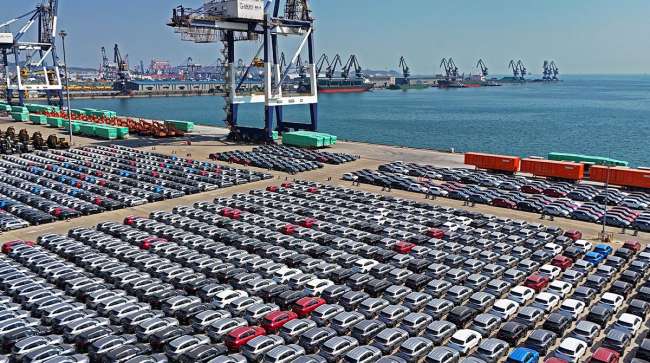An aerial view of new cars waiting for shipment at a pier for ro-ro ships in Yantai city in eastern China’s Shandong province. (Chinatopix Via AP)
BEIJING — China announced April 11 that it will raise tariffs on U.S. goods from 84% to 125% — the latest salvo in an escalating trade war between the world’s two largest economies that has rattled markets and raised fears of a global slowdown.
While U.S. President Donald Trump paused import taxes this week for other countries, he raised tariffs on China and they now total 145%. China has denounced the policy as “economic bullying” and promised countermeasures. The new tariffs begin April 12.
Washington’s repeated jacking up of tariffs “will become a joke in the history of the world economy,” a Chinese Finance Ministry spokesman said in a statement announcing the new tariffs. “However, if the U.S. insists on continuing to substantially infringe on China’s interests, China will resolutely counter and fight to the end.”
China’s Commerce Ministry said it would file another lawsuit with the World Trade Organization against the U.S. tariffs.
MOFCOM Spokesperson’s Remarks on China’s Supplementary WTO Lawsuit against U.S. Escalation of Tariff Measures
Q: It is reported that China has filed an additional complaint at the WTO regarding the United States’ further imposition of 50% tariffs on Chinese products. Could you…
— 中华人民共和国商务部MOFCOM (@MOFCOM_China) April 11, 2025
“There are no winners in a tariff war,” Chinese leader Xi Jinping said during a meeting with the Spanish Prime Minister Pedro Sanchez, according to a readout from state broadcaster CCTV. “For more than 70 years, China has always relied on itself … and hard work for development, never relying on favors from anyone, and not fearing any unreasonable suppression.”
Trump’s on-again, off-again measures have caused alarm in stock and bond markets and led some to warn that the U.S. could be headed for a recession. There was some relief when Trump paused the tariffs for most countries — but concerns remain since the U.S. and China are the world’s No. 1 and No. 2 economies, respectively.
The trade war between the U.S. and China “could severely damage the global economic outlook,” the head of the WTO, Ngozi Okonjo-Iweala, said earlier this week.
I am greatly concerned about the escalating tit for tat tariff war between the United States and China, the world’s two largest economies. Click on the link to read my statement.https://t.co/sv4uCr4Qcq
— Ngozi Okonjo-Iweala (@NOIweala) April 9, 2025
Chinese tariffs will affect goods like soybeans, aircraft and their parts and drugs — all among the country’s major imports from the U.S. Beijing, meanwhile, suspended sorghum, poultry and bonemeal imports from some American companies last week, and put more export controls on rare earth minerals, critical for various technologies.
The United States’ top imports from China, meanwhile, include electronics, like computers and cellphones, industrial equipment and toys — and consumers and businesses are likely to see prices rise on those products, with tariffs now at 145%.
Trump announced April 9 that China would face 125% tariffs, but he did not include a 20% tariff on China tied to its role in fentanyl production.
White House officials hope the import taxes will create more manufacturing jobs by bringing production back to the United States — a politically risky tradeoff that could take years to materialize, if at all.






